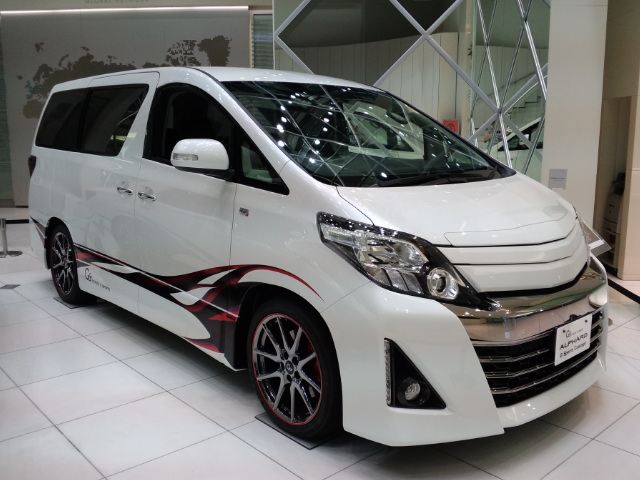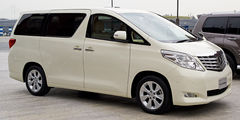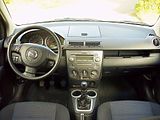Toyota ALPHARD
PT BENDI METAL PERKASA | 8/13/2013 |

The Toyota Alphard is a luxury MPV (minivan) produced by the Japanese automaker Toyota since 2002. It is available as a seven- or eight-seater with 2.4 and 3.0 litre gasoline engines in 3 different model lines - Alphard G, Alphard V, and the Alphard Hybrid, which uses the 2.4 litre engine along with an electrical motor and batteries. Toyota states its "E-Four electric 4WD system that regulates a rear-mounted, rear-wheel-propelling electric motor and coordinates electric power distribution to all four wheels. An ECB (Electrically Controlled Brake system) provides efficient wheel-by-wheel brake control." The vehicle was named after theAlphard, the brightest star in the constellation Hydra.
The Alphard is primarily made for the Japanese market, but is also sold in Bahrain, Bangladesh, China, Hong Kong, Indonesia,Oman, Philippines, Russia,[2] Singapore, Taiwan and Thailand.
In 2006, a Royal Lounge Alphard was introduced. It is a luxurious, four-seat version of the Alphard. Its traditional competitor from Nissan is the Elgrand. Toyota also makes a sportier version of the Alphard with black interior, aimed at the younger generation, called the Vellfire.
Contents
[hide]Alphard Hybrid
The full-size Alphard Hybrid MPV qualifies as an Ultra-Low Emissions Vehicle (ULEV), achieving emission levels 75% lower than the Japanese government's year 2000 benchmark. The 2.4-litre gasoline engine has been developed specifically for use in Toyota's hybrid systems and features a high-expansion ratio cycle that raises efficiency and reduces friction.
The Alphard Hybrid uses "by-wire" technology that monitors brake pedal pressure and vehicle speed in order to calculate the optimum hydraulic pressure. By-wire works with the E-Four to maximize the collection of kinetic energy from braking for conversion into electric power.
The Alphard Hybrid can generate up to 1,500 watts and is equipped with standard 100-volt AC power outlets, allowing a wide range of appliances to be used, such as laptops and emergency lights. The electrical outlets can also be used to recharge items such as power-assisted bicycles and electric carts, adding a new dimension to leisure activities.
Safety features
In fact, standard on the "G edition" and optional on standard grades are ( with a G-BOOK compatible DVD voice navigation system):
- Blind Corner Monitor, which indicates the approach of other vehicles or pedestrians from the left and right
- Back Guide Monitor with a color CCD camera and voice-guidance function, which uses signals from a steering sensor to calculate the likely reverse path during reversing and display it on the monitor screen
- Lane-monitoring system that uses images from the Back Guide Monitor camera to measure the lateral distance to white or yellow lines on major highways and triggers an alarm when the distance falls below a pre-set level
- Radar Cruise Control, which uses laser radar sensors and steering sensors to keep track of the vehicle's lane and any preceding vehicle and ensures that a safe distance is maintained in accordance with vehicle speed
Built-in electronic toll collection
In addition, optional on all grades is a built-in electronic toll collection unit that allows for quick tollgate pass-through (only available with a navigation system).
Fuel efficiency
The Alphard Hybrid achieves approximately 42 mpg and boasts an insulated body and newly developed two-way compressor that is incorporated in the motor to optimize the use of the air conditioner, conserving fuel. The Alphard Hybrid's specially developed windshield glass also reduces the amount of solar radiation penetration. In addition, the roof and roof panels contain an insulating material to reduce cabin temperature, which helps conserve energy when the air conditioner is operating.
1st generation (2002-2008)
 | |
| Manufacturer | Toyota |
|---|---|
| Production | 2002 - 2007 |
| Assembly | Japan |
| Class | Large MPV |
| Body style | 4 or 5 door MPV |
| Engine | 2.4 L 2AZ-FE I4 160hp 3.0 L 1MZ-FE V6 220hp |
| Transmission | 4-speed automatic (2.4L & 2002-2005 3.0L) 5-speed automatic (3.0L 2005-2008) |
| Wheelbase | 2,900 mm (110 in) |
| Length | 4,840 mm (191 in) |
| Width | 1,805 mm (71.1 in) |
| Height | 1,935 mm (76.2 in) |
| Curb weight | 1,790 kg (3,900 lb) |
The Alphard was produced by Toyota in 2002 to compete against the Nissan Elgrand and Honda Elysion. With full electrical component features and complete comfort and safety features, the Alphard is Toyota's best selling MPV in Japan. The Alphard was facelifted in 2005 with new design of rear lamp and use of 16" and 17" alumunium alloy wheels. A hybrid version was also added to the lineup. For model year 2007 on Japanese models only, G-BOOK, a subscription telematics service, is offered as an option.
Actor Jean Reno appeared on Japanese TV commercials for the Toyota Alphard.
Technical details Engine
- 2AZ-FE 2400 cc 4 cylinders 16 valve VVT-i 160 PS (118 kW; 158 hp) 195 N·m (144 lb·ft)
- 1MZ-FE 3000 cc V6 24 valve VVT-i 220 PS (162 kW; 217 hp) 310 N·m (230 lb·ft)
- Transmission
- 4&5 speed automatic super ECT
- Drivetrain
- FWD
- 4WD
- Dimension and weight
- Length : 4,865 mm (191.5 in)
- Width : 1,830 mm (72.0 in)
- Height : 1,935 mm (76.2 in)
- Wheelbase : 2,900 mm (114.2 in)
- Weight : 1,800 kg (4,000 lb)
2nd generation (2008-present)
 | |
| Manufacturer | Toyota |
|---|---|
| Also called | Toyota Vellfire |
| Production | 2007 - present |
| Assembly | Japan |
| Class | Large MPV |
| Body style | 4 or 5 door MPV |
| Engine | 2.4 L 2AZ-FE I4 168hp 3.5 L 2GR-FE V6 266hp-276hp |
| Transmission | 7-speed Super CVT-i (2.4L) 6-speed automatic (3.5L) |
| Wheelbase | 2,950 mm (116 in) |
| Length | 4,840 mm (191 in) |
| Width | 1,830 mm (72 in) |
| Height | 1,905 mm (75.0 in) |
| Curb weight | 1,910 kg (4,200 lb)(Base I4) 1,985 kg (4,380 lb)(Base V6) 1,995 kg (4,400 lb)(Top Trim I4) 2,070 kg (4,600 lb)(Top Trim V6) |
In April 2008, the Alphard was redesigned with a more modern style of exterior and a more luxurious interior. For this generation, the Alphard line-up was expanded into two different design variant - Alphard and Vellfire. According to Toyota's press release, the Alphard is described as having elegant and sophisticated design while the Vellfire emphasizes on strength and strong individuality. Both models are sold via separate distribution channels, with the Alphard sold by Toyota's Toyopet dealership chain while the Vellfire is sold at Toyota's youth oriented Netz dealership chain.[3][4]
The 2nd generation Alphard launched in the Philippines on August 3, 2010.[5]
A facelift model was announced by Toyota Motor Co. on 27-September 2011, with sales in Japan to start from 1-November 2011. Also introduced is a hybrid version of both the Alphard and Vellfire.[6]
Technical details Engine
- 2AZ-FE 2,362 cc I4 cylinders 16 valve VVT-i 170 PS (125 kW; 168 hp) 235 N·m (173 lb·ft)
- 2GR-FE 3,456 cc V6 24 valve 280 PS (206 kW; 276 hp) 330 N·m (240 lb·ft)
- Transmission
- 4 speed automatic
- 6 speed automatic super ECT
- 7 speed automatic super CVT
- Drivetrain
- FWD
- 4WD
- Dimension and weight
- Length : 4,840 mm (190.6 in)
- Width : 1,830 mm (72.0 in)
- Height : 1,905 mm (75.0 in)
- Wheelbase : 2,950 mm (116.1 in)
- Weight : 1,910 kg (4,200 lb)
See also
References
- ^ "Toyota Alphard Minivan Now Sold in Russia". Wroom.ru. 25 October 2011. Retrieved 25 December 2012.
- ^ "Press release : Toyota Alphard and Vellfire launch (Japanese)". Toyota Motor Co.
- ^ "Alphard and Vellfire Facelift, Hybrid added". MotorIndustry.org.
- ^ Patrick Everett Tadeo (2010-08-02). "Toyota Motor Philippines launches new Alphard minivan". Retrieved 2011-08-09.
- ^ "Press release : Alphard and Vellfire launch (Japanese only)". Toyota Motor Co.
Mazda 2
PT BENDI METAL PERKASA | 5/10/2013 |
New MAZDA 2
Der Mazda2 ist ein frontgetriebener Kleinwagen des japanischen Herstellers Mazda, der seit Frühjahr 2003 gebaut wird und sich seit Herbst 2007 in nunmehr zweiter Generation befindet.
Er ist in Europa der Nachfolger des Mazda Demio,
während letzterer auch noch gebaut und in einigen Ländern verkauft
wird. In der Modellpalette des Herstellers ist er am unteren Ende
unterhalb des Mazda3 platziert.
2 (Typ DY, 2003–2007)
| 1. Generation | |
|---|---|
|
Mazda2 (2003–2005)
|
|
| Produktionszeitraum: | 2003–2007 |
| Karosserieversionen: | Steilheck, fünftürig |
| Motoren: | Ottomotoren: 1,2–1,6 Liter (55–74 kW) Dieselmotoren: 1,4 Liter (50 kW) |
| Länge: | 3952 mm |
| Breite: | 1680 mm |
| Höhe: | 1530 mm |
| Radstand: | 2490 mm |
| Leergewicht: | 1125–1207 kg |
Die im April 2003 eingeführte erste Generation des Mazda2 basierte auf der Plattform des Ford Fusion und orientierte sich beim Design am Vorgänger, dem Mazda Demio. Ein auffallendes äußeres Merkmal des Mazda2 war die kleinwagenuntypisch hohe Fahrgastzelle, die eher an einen Minivan
erinnert. Da der Mazda2 aber nur über eine gewöhnliche, klappbare
Rücksitzbank und -lehne verfügte, wurde er als Kleinwagen und nicht als
Minivan angesehen. Gebaut wurde er im spanischen Ford-Werk Almussafes bei Valencia.
Im Frühjahr 2005 erfolgte ein leichtes Facelift, bei dem Scheinwerfer
und Schürzen aufgewertet wurden sowie neue Stoffe und Farben zum
Einsatz kamen. Neu gab es auch Klarglasheckleuchten und veränderte,
kleinere Nebelscheinwerfer.
Motoren
Im Laufe des Modellzyklus wurden die Motoren und Getriebevarianten immer wieder leicht überarbeitet. So war das automatisierte Schaltgetriebe
bis 2006 auch im 1,4-l-MZ-CD-Diesel erhältlich. Zudem erfüllte derselbe
Motor seit dem Facelift 2005 durch ein neues Steuergerät die Abgasnorm
Euro 4.
| Modell | Hubraum | Leistung | Drehmoment | Getriebe | Bauzeit |
|---|---|---|---|---|---|
| Ottomotoren | |||||
| 1.25 MZI | 1242 cm³ | 55 kW (75 PS) bei 6000 min−1 | 110 Nm bei 4000 min−1 | Fünfgang-Schaltgetriebe | 2003–2007 |
| 1.4 MZI | 1388 cm³ | 59 kW (80 PS) bei 5700 min−1 | 124 Nm bei 3500 min−1 | Fünfgang-Schaltgetriebe oder automatisiertes Fünfganggetriebe |
2003–2007 |
| 1.6 MZI | 1596 cm³ | 74 kW (101 PS) bei 6000 min−1 | 146 Nm bei 4000 min−1 | Fünfgang-Schaltgetriebe | 2003–2007 |
| Dieselmotor | |||||
| 1.4 MZ-CD | 1399 cm³ | 50 kW (68 PS) bei 4000 min−1 | 160 Nm bei 2000 min−1 | Fünfgang-Schaltgetriebe oder automatisiertes Fünfganggetriebe |
2003–2007 |
2 (Typ DE, seit 2007)
| 2. Generation | |
|---|---|
|
Mazda2 (2007–2010)
|
|
| Produktionszeitraum: | seit 05/2007 |
| Karosserieversionen: | Schrägheck, drei-/fünftürig Stufenheck, viertürig |
| Motoren: | Ottomotoren: 1,3–1,5 Liter (55–76 kW) Dieselmotor: 1,4–1,6 Liter (50–70 kW) |
| Länge: | 3885–3920 mm |
| Breite: | 1695 mm |
| Höhe: | 1475 mm |
| Radstand: | 2490 mm |
| Leergewicht: | 954–1035 kg |
| Sterne im Euro NCAP-Crashtest[1] |
Am 20. Oktober 2007 fand in Deutschland die Markteinführung der
zweiten Generation des Mazda2 statt. Durch "Downsizing" fällt diese vier
Zentimeter kürzer aus und basiert auf einer neuen Plattform, die auch
der neue Ford Fiesta nutzt.
Als Produktionsstandort wurde Ujina im japanischen Hiroshima
ausgewählt, dort lief am 22. Mai 2007 das erste Fahrzeug vom Band. Im
Gegensatz zur kastenförmigen ersten Generation ist das neue Modell ein
reiner Kleinwagen, ohne optische Anleihen an einen Minivan.
Neben der geringeren Länge von nun 3,88 Metern sank auch das Gewicht um
rund 100 kg, wodurch ebenfalls der Kraftstoffverbrauch sinken soll. Das
Kofferraumvolumen beträgt je nach Stellung der Sitzlehnen 250 bis 787
Liter (Kofferraumvolumen, l nach VDA / umgelegte 2. Sitzreihe dachhoch);
sechs Airbags und ESP sind serienmäßig.
Zum Verkaufsstart bot Mazda zunächst nur eine fünftürige Version an. Ein Dreitürer namens Mazda2 Sport folgte auf dem Genfer Automobilsalon und wird seit Juni 2008 verkauft.[2]
Die Preise beginnen bei 11.950 Euro (Mazda2 Sport) und 12.650 Euro (Mazda2) für die Basisversion Impuls und liegen somit etwas unter denen der alten Generation. Neben der Basis gibt es auch noch die Ausstattungen Independence und Impression.
2008 startete auch eine hauptsächlich für den chinesischen Markt
vorgesehene Version mit Stufenheck. Diese wurde auf der Guangzhou Motor
Show am 20. November vorgestellt. Durch die Verlängerung der Heckpartie
um 37 Zentimeter wuchs das Kofferraumvolumen auf 450 Liter. Im
Stufenheck sind die beiden größeren Ottomotoren erhältlich und auch eine
Vier-Stufen-Automatik.[3]
Seit Anfang 2009 ist der Mazda2 auch mit der Ausstattungsvariante
"Dynamic" zu haben, welche auf "Impression" aufsetzt und zusätzlich ein
Sport-Optik-Paket enthält.
Im Oktober 2010 wurde dem Mazda2 ein dezentes Facelift unterzogen, bei dem der vordere Stoßfänger neu gestaltet wurde.
Motoren
Zu den seit Verkaufsbeginn erhältlichen und neu entwickelten
Ottomotoren mit 1,3 oder 1,5 Litern Hubraum kam 2008 noch ein 50 kW
(68 PS) starker 1,4-l-Common-Rail-Dieselmotor hinzu. Dieser wurde im
Juni 2009 von einem neuen 66 kW (90 PS) starken
1,6-l-Common-Rail-Dieselmotor abgelöst.Bei allen Motorisierungen handelt es sich um Reihen-Vierzylinder.
Elektroantrieb
Ab Oktober 2012 wird der Mazda 2 (Demio) in Japan erstmals auch mit
Elektroantrieb im Rahmen eines Leasingprogramms angeboten. Die Leistung
des Mazda 2 EV beträgt 75 kW (102 PS) und die Reichweite des
Elektroautos soll nach dem japanischen JC08 Fahrzyklus 200 Kilometer
betragen. Beim Platzangebot unterscheidet sich der Fünfsitzer nicht vom
konventionell angetriebenen Modell.
























